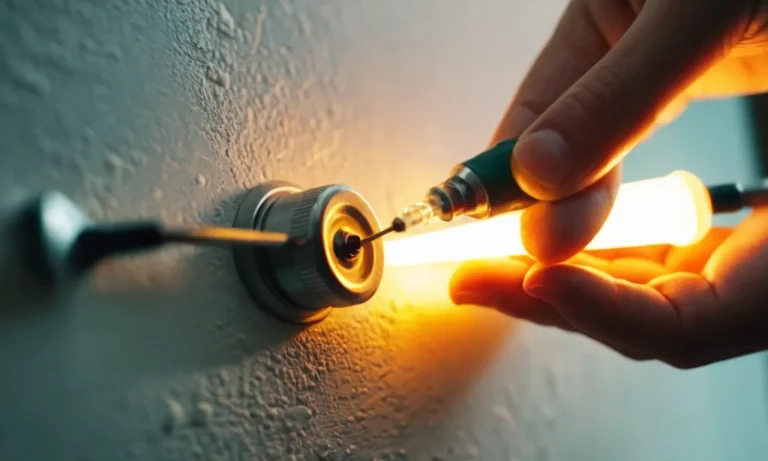Can Acrylic Paint Be Used On Plastic? A Detailed Guide
Painting plastic items with acrylic paint is a fun and creative way to give them new life and color. If you have plastic items around your home that could use a lift – think toys, storage bins, flower pots, etc. – using acrylic paint on them can totally transform their look.
But before breaking out the paint brushes, you may be wondering: can you actually use acrylic paint on plastic without ruining the plastic? Let’s dive in to find out.
If you’re short on time, here’s the quick answer: Yes, acrylic paint can generally be used on plastic without issue as long as the plastic is properly prepared first. Lightly sanding the plastic and using a primer or adhesion promoter will help the paint stick to the non-porous surface better.
Clean and Sand the Plastic
Before applying acrylic paint on plastic, it is important to properly clean and prepare the surface. This will ensure better adhesion and a smoother finish. Let’s take a look at two key steps in this process.
Use soap and water to clean
The first step is to clean the plastic surface using soap and water. This will remove any dirt, grease, or other contaminants that might interfere with the paint’s ability to adhere to the plastic. Use a mild dish soap and warm water, and gently scrub the surface with a soft cloth or sponge.
Rinse thoroughly and allow the plastic to dry completely before moving on to the next step.
Lightly sand for better adhesion
After the plastic is clean and dry, it is recommended to lightly sand the surface. This will create a rough texture that allows the paint to adhere more effectively. Use a fine-grit sandpaper and gently sand the plastic in circular motions.
Be careful not to apply too much pressure as it may damage the plastic. Once you have sanded the surface, wipe away any dust with a clean cloth.
Pro Tip: If you are working with a smooth plastic surface, you can use a plastic primer before applying acrylic paint. This will help create a stronger bond between the paint and the plastic.
For more detailed instructions on cleaning and sanding plastic surfaces, you can visit www.diynetwork.com. They provide helpful tips and step-by-step guides to ensure you achieve the best results.
Apply Primer or Adhesion Promoter
Primer creates a bonding layer
When it comes to using acrylic paint on plastic, applying a primer is highly recommended. Primer acts as a bonding layer between the plastic surface and the paint, ensuring better adhesion and durability of the paint job.
The primer helps to create a smooth and even surface, allowing the paint to adhere properly and prevent peeling or chipping.
Primer is specifically designed to promote adhesion on different surfaces, including plastic. It helps to seal the porous surface of the plastic, preventing the paint from being absorbed unevenly. Additionally, primer also helps to improve the coverage and color vibrancy of the acrylic paint, resulting in a more professional-looking finish.
There are various types of primers available in the market that are specifically formulated for plastic surfaces. It is important to choose a primer that is compatible with both acrylic paint and plastic to ensure the best results.
It is recommended to read the instructions on the primer label and follow the manufacturer’s guidelines for the application process.
Adhesion promoter etches the plastic
In some cases, using an adhesion promoter instead of or in addition to a primer can be beneficial. Adhesion promoters are specifically designed to etch the plastic surface, creating a better bond between the paint and the plastic.
An adhesion promoter contains chemicals that react with the plastic surface, creating microscopic abrasions. These abrasions help the paint to adhere more effectively, increasing its longevity and preventing peeling or flaking.
Adhesion promoters are particularly useful when working with smooth or glossy plastic surfaces that may be more challenging for the paint to adhere to.
It is important to note that adhesion promoters should be used with caution, as they can be quite potent. It is recommended to follow the manufacturer’s instructions carefully and use them in a well-ventilated area.
Additionally, it is advisable to do a small test patch on a discreet area of the plastic surface to ensure compatibility and desired results.
When using both primer and adhesion promoter, it is generally recommended to apply the primer first and then follow it up with the adhesion promoter. This combination helps to ensure maximum adhesion and durability of the acrylic paint on plastic surfaces.
Paint! But Avoid Enamel Acrylics
When it comes to painting plastic surfaces, acrylic paint is a popular choice for many artists and DIY enthusiasts. It offers a versatile and vibrant option for adding color and creativity to plastic items such as toys, furniture, and even car parts.
However, not all types of acrylic paint are suitable for painting on plastic.
2-3 thin coats work best
When using acrylic paint on plastic, it’s important to apply thin coats rather than one thick layer. This allows the paint to adhere better to the plastic surface and reduces the chances of the paint peeling or cracking. Applying 2-3 thin coats also ensures a more even and smooth finish.
It’s advisable to wait for each coat to dry completely before applying the next one. This helps to prevent the paint from smudging or smearing, ensuring a neat and professional-looking result. Patience is key when working with acrylic paint on plastic!
Enamel acrylics take longer to dry
While most types of acrylic paint can be used on plastic, it’s important to avoid using enamel acrylics. Enamel acrylics are formulated with a different binder that takes longer to dry, and they may not adhere well to plastic surfaces.
Using enamel acrylics on plastic can result in a paint job that easily chips, peels, or becomes sticky.
Instead, opt for acrylic paints specifically designed for use on plastic surfaces. These paints have a formulation that allows them to adhere better to plastic, ensuring a longer-lasting and more durable finish.
They also tend to dry more quickly, reducing the waiting time between coats and allowing you to complete your project faster.
Remember to always read the instructions provided by the paint manufacturer to ensure you are using the correct type of acrylic paint for your plastic surface. Additionally, prepping the plastic surface by cleaning it thoroughly and using a primer specifically designed for plastic can also help improve paint adhesion and durability.
For more information on painting plastic with acrylics, you can visit the Art is Fun website, which offers a detailed guide on the topic.
Seal and Protect the Painted Plastic
Once you have successfully painted plastic using acrylic paint, it is important to seal and protect your artwork to ensure its longevity. By applying a sealant, you can prevent the paint from chipping or peeling off over time.
This step is crucial, especially if the painted plastic will be subjected to frequent use or outdoor conditions.
Sealants protect paint from chipping/peeling
There are various types of sealants available in the market that are specifically designed for protecting painted surfaces. These sealants create a protective barrier over the paint, preventing it from getting damaged or wearing off easily.
It is recommended to choose a sealant that is compatible with acrylic paint and plastic. You can find these sealants in local craft stores or online.
Pro Tip: Before applying the sealant, make sure the painted plastic is completely dry. This will ensure better adhesion and a smoother finish.
Polyurethane works for indoor items
If you are painting plastic items intended for indoor use, using a polyurethane sealant can be an excellent choice. Polyurethane provides a clear, glossy finish that protects the paint from scratches and fading. It is easy to apply and dries relatively quickly.
Make sure to follow the manufacturer’s instructions for application and drying times.
Did you know? Polyurethane sealants can also be used on other surfaces like wood or metal to protect the painted finish.
Outdoor pieces need UV-resistant sealer
For plastic items that will be exposed to outdoor elements, it is crucial to use a sealant that is UV-resistant. UV rays from the sun can cause the paint to fade and deteriorate over time. Look for a sealant that specifically mentions UV protection on the label.
This will help your painted plastic withstand the harsh effects of the sun and retain its vibrant colors for longer.
Expert Tip: When using a UV-resistant sealant, it is still advisable to keep your painted plastic items away from direct sunlight as much as possible to maintain their longevity.
| Sealant Type | Recommended for | Advantages |
|---|---|---|
| Polyurethane | Indoor items | Clear, glossy finish; protects from scratches |
| UV-resistant sealant | Outdoor items | Protects against fading and deterioration caused by UV rays |
Remember, sealing and protecting your painted plastic is essential for maintaining its beauty and durability. By choosing the right sealant and following the correct application techniques, you can ensure that your artwork remains intact for years to come.
For more information on sealants and protective coatings for painted plastic, you can visit the website of Plastics Painting, a trusted resource in the field.
Maintenance Tips
Handle gently while drying
When using acrylic paint on plastic, it is important to handle the painted item with care while it is drying. Acrylic paint can take some time to fully dry, and during this period, it can be susceptible to smudging or smearing if not handled gently.
Avoid touching the painted surface directly and try to place the item on a flat surface where it won’t be disturbed. This will help ensure a smooth and even drying process.
Avoid soaking painted plastic
While acrylic paint is generally quite durable, it is still important to avoid soaking painted plastic items in water or any other liquids. Excessive exposure to moisture can cause the paint to soften or peel off, compromising the overall appearance of the item.
If you need to clean a painted plastic surface, use a soft, damp cloth or sponge and gently wipe the surface without applying too much pressure. This will help maintain the integrity of the paint.
Touch up scratches as needed
Over time, painted plastic items may develop scratches or minor damages. To keep your acrylic paint looking fresh and vibrant, it is a good idea to periodically touch up any scratches or imperfections. This can be done by using the same type and color of acrylic paint that was originally used.
Apply a small amount of paint to the affected area and carefully blend it in with the surrounding paint. This simple maintenance step can help prolong the life of your painted plastic items.
Conclusion
Painting plastic with acrylics opens up so many possibilities for DIY projects and upcycling. Just be sure to properly prepare the plastic first by cleaning, sanding, and priming so the paint adheres correctly. Add 2-3 thin layers of acrylic paint, then seal the paint job for protection.
With a little planning and prep work, acrylic paint can make plastic items pop with new life and color.
For a quick recap: clean, sand, prime, paint, and seal plastic items to successfully use acrylic paint. Handle with care while drying and avoid soaking. Touch up paint as needed over time. Now get creative and enjoy painting plastic with versatile acrylics!







